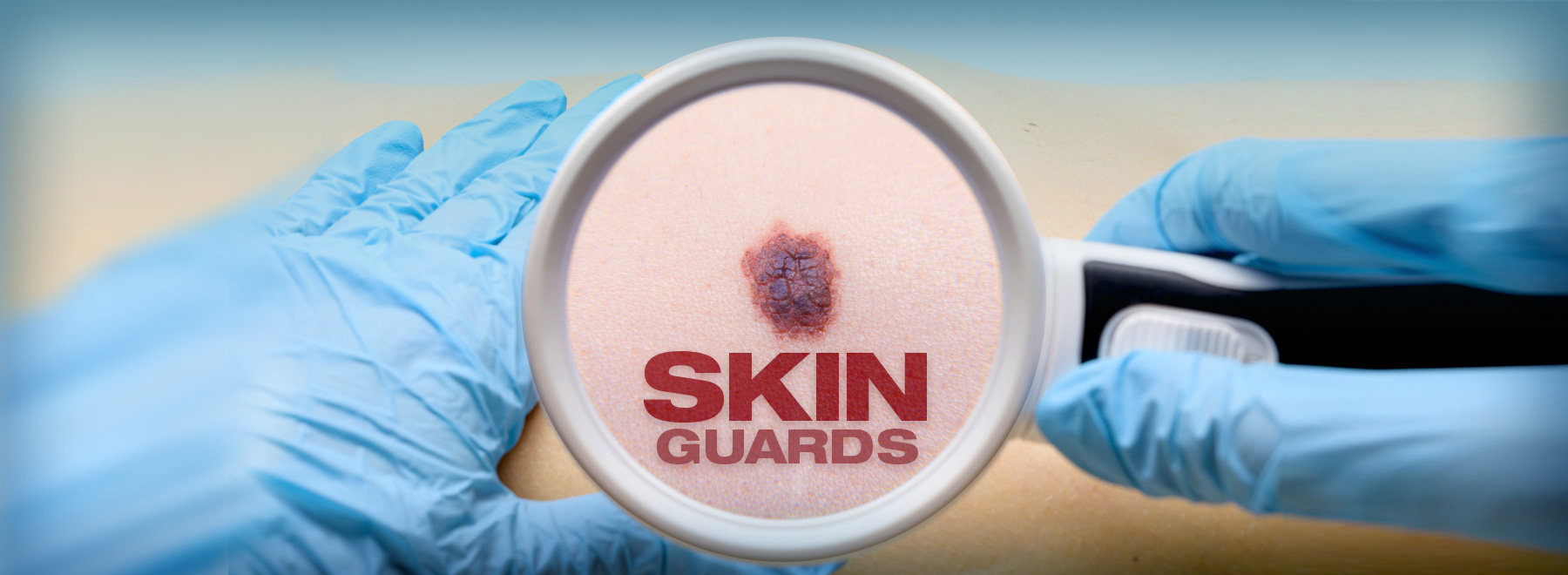How to keep cancer from damaging ‘indispensable barrier’
It is the largest and heaviest organ in the human body, protecting us from disease and injury; storing blood and water; keeping us cool or warm, depending on our needs; and allowing us to touch the world.
And still, we pierce it, dye it, stamp it, let perfect strangers push ink into it and, maybe, most of all, bake it like a biscuit.
Our skin is our friend, but often we treat it more like a disposable product. It is indispensable, though, and we need to keep it healthy and safe, especially from the most common cancer in the United States.
The scourge of skin cancer - which at least one in five Americans will develop by age 70 - is defined by three main types: squamous cell carcinoma, basal cell carcinoma and melanoma. What you do to prevent one can prevent them all.

“These three diseases are all cancer; they are all malignant and can all do local damage,” said Dr. Robert Brodell, professor and chair of dermatology at the University of Mississippi Medical Center. “But when cancer spreads its seeds around the body, that is the worst thing regarding someone’s life and health.”
That process is called metastasization.
Basal cell carcinoma, known as “the sore that won’t heal,” does not metastasize, Brodell said. Often, it develops on a sun-exposed area of the skin.
“Look closely; the edges may be pearly,” Brodell said. “You may see blood vessels on a surface of pearly growth that’s generally next to a crusted sore. The tumor is not normal skin, so when it gets bumped out and outgrows its blood supply, it crusts.”

Basal cell is the most common of the three, said Dr. Kimberley Ward, professor of dermatology and director of cosmetic dermatology at UMMC. “It often appears as a red bump that looks like a pimple but doesn’t go away in a couple of weeks.
“It can also look like red, rough skin that might be sensitive or bleed easily,” said Ward, who sees patients at the UMMC Face and Skin Center in Ridgeland. “And it tends to grow. Typically, it remains confined to the skin, rather than spreading internally, but it can grow locally and cause tissue damage, and when it does so in the face and neck, it can be disfiguring. So early detection and treatment is key.”
Squamous cell, the second-most common type, is frequently a “crusted, warty growth that is enlarging, sometimes painful,” Brodell said. “Some forms of this are dome-shaped; they look sort of like a volcano with a crust in the center.
“They also can grow rapidly. If you’ve never had a lesion (abnormal-looking tissue) like that before, see a doctor.”
Squamous cell doesn’t usually metastasize; it can, but rarely, Brodell said.
It can be easily treated through surgery, if caught early, Ward said.
Melanoma, though, is probably the most feared diagnosis when people hear the words “skin cancer.”
“Melanoma is a bad actor,” Brodell said. “It commonly metastasizes if you ignore it. And the longer it is on your skin and the deeper it grows into your skin, the more likely it is to metastasize.
“Melanoma is a change in a mole, generally, a pigmentation change. Usually, it will be a brown or black lesion that looks different from the rest of your lesions; it may be growing and changing.”
Any change is concerning, he said.
“It could be itching, bleeding, turning darker, growing sideways like a pseudopod. With any new, or changing, mole, it’s always good to talk about it with your primary care doctor or dermatologist.
“We want to remove it and have proof that it has been completely removed by looking at the margins of the incision or in some cases, have it treated with Mohs surgery. Even if we see that it is completely removed, if you see something that has grown back, you would promptly show that to your doctor.”
- When trying to spot melanoma, use the mnemonic ABCDE, Ward said:
- Asymmetry (Is the spot or lesion uneven, lopsided?)
- Border (Is the border irregular or jagged?)
- Color (Does it have more than one color?)
- Diameter (Is the diameter greater than six millimeters, or about one-fourth of an inch?)
- Evolution (is it changing?)
“I love for my patients to do self-skin checks,” Ward said. “Because skin cancer will, by definition, be changing.
“Patients can spot skin cancer early.”
If you want to let your physician know immediately that you’ve noticed something, you can email or text a photo of it.
“But many patients have trouble taking an image that’s in focus or is well-lit,” Brodell said. “This ties their dermatologist’s hands. If convenient, it’s better to let your dermatologist see the spot during an in-person visit. Take a felt-tip pen, and let your spouse do the same for you, and circle those areas that are concerning.
“If your doctor does a biopsy, someone should get back to you within a week. But people often don’t answer the phone anymore if they don’t recognize a number. So if you haven’t heard anything within a week, call your doctor’s office, or the next thing you know, weeks or months go by. And you could have a worse problem.”
Of course, it’s better to head off cancer before a problem starts.
“Sun protection is the No. 1 thing you can do to decrease your risk of skin cancer,” Ward said. “Sunscreen is important, but it’s just a screen, it’s not a block. So I ask my patients to think about it in a layered approach.”
These are the layers: sunscreen, broad-brimmed hat, sunglasses, sun-protective clothing.
“And seek shade as much as possible when outdoors,” Ward said. “If you have a choice about what time you’re outdoors, avoid 10 a.m. to 2 p.m., when the UV rays are strongest.
“Use sunscreen that is SPF (Sun Protection Factor) 30 or higher. It’s really important to apply it properly. You really want to put a good layer of sunscreen on, not just a thin coat. The average adult needs about an ounce.”
That’s especially true if you’re at the beach in a swimsuit, she said.
“A bottle of sunscreen really shouldn’t last very long.”
A sunscreen labeled “water-resistant” is best if you are swimming or immersed in other water-related activities, Ward said.
“Also, if you are sweating a lot. Water-resistant sunscreen, depending on the product, is protective for either 40 or 80 minutes. But you need to re-apply any sunscreen if you’re outdoors for very long.”
Whatever sunscreen you use, make sure the label reads “broad spectrum, meaning it covers UVA and UVB rays,” Ward said.
Pick a sunscreen you like, Brodell said.
“If you put it on and you sweat and gets in your eyes and this bothers you, then change it. Use one that is more water-resistant.”
Sunscreens come in two main types: mineral and chemical.
Mineral sunscreen ingredients, such as zinc oxide and titanium dioxide, perch on the skin and block ultraviolet rays.
“You have to rub it in, but it tends to be more waterproof and doesn’t sting like some chemical sunscreens,” Brodell said.
Chemical sunscreen is absorbed into the skin, where it converts radiation to heat, which leaves the body. Oxybenzone, avobenzone, octisalate, octocrylene, homosalate and octinoxate are some of the more common chemical sunscreen ingredients, Ward said.
“It rubs in easily and goes on quickly,” Brodell said, “and you can always reapply it if you’re swimming or sweating a lot.”
As if the sun’s rays aren’t powerful enough, some prescription medications can muscle them up. Among the drugs that can exaggerate a sunburn are tetracycline antibiotics, which treat respiratory tract infections and certain infections of the skin, eye, intestinal system, urinary system and other systems; and hydrochlorothiazide, or the water pill, a treatment for high blood pressure.
Pain relievers called NSAIDs (non-steroidal anti-inflammatory), such as ibuprofen, can make you more sensitive to UV rays, Ward said.
“But aspirin is not a big culprit.”
This does not mean you should automatically stop taking your medication, Brodell said.
“Talk to your doctor about it first, and be even more careful about protecting yourself from the sun’s rays.
And be careful of your margarita.”
Or of any concoction where stray lime juice may cause phytophotodermatitis.
“Phytotoxic (poisonous-to-plants) inflammation can occur when light-sensitizing botanical agents on your skin are exposed to direct sunlight,” Brodell said. “The most common examples are caused by lime, which is squeezed into your drink by you or a bartender just before exposure to the sun, causing this blistering reaction.”
The above article appears in CONSULT, UMMC’s monthly e-newsletter sharing news about cutting-edge clinical and health science education advances and innovative biomedical research at the Medical Center and giving you tips and suggestions on how you and the people you love can live a healthier life. Click here and enter your email address to receive CONSULT free of charge. You may cancel at any time.



